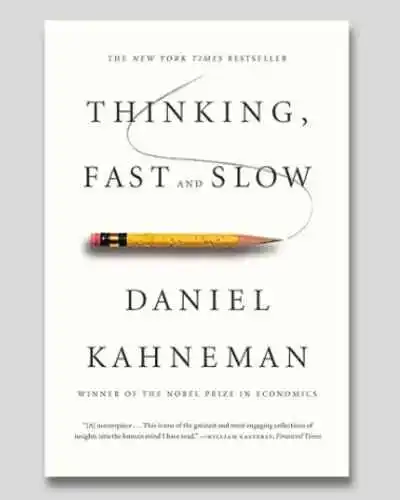Thinking, Fast and Slow is a seminal work by psychologist and Nobel Prize-winning economist Daniel Kahneman.
First published in 2011, the book delves into the intricate workings of the human mind and provides a detailed analysis of how we make decisions.
It debunks the illusion that we always think rationally, revealing that our brain operates in two systems: one fast and intuitive, and the other slower and more deliberate.
Spanning over 500 pages, this book is not only informative but also transformative. Kahneman draws on decades of research in cognitive psychology and behavioral economics to demonstrate that we are often misled by our own minds.
Through everyday examples and rigorous scientific studies, he illustrates how these systems of thought influence everything from simple choices, like what to eat for lunch, to complex decisions, such as financial investments or public policies.
More than a psychology book, Thinking, Fast and Slow is a practical guide for understanding how the human mind works and, more importantly, how to avoid cognitive pitfalls.
..
..
Analysis of the Book’s Central Idea
The central idea of the book lies in the dichotomy between two modes of thinking, which Kahneman refers to as System 1 and System 2:
:: System 1
This is fast, automatic, intuitive, and often emotional. It is the part of the brain that kicks into action almost effortlessly, helping us react quickly to routine or emergency situations.
It is responsible for automatic interpretations, such as recognizing familiar faces, interpreting emotions in facial expressions, or instinctively deciding whether a situation is dangerous.
..
:: System 2
In contrast, this system is slow, logical, analytical, and deliberate. It requires cognitive effort and is engaged in tasks that demand focus, such as solving math problems, developing strategies, or planning long-term projects.
These two systems coexist and interact in fascinating ways. However, System 1 tends to dominate, even in situations where System 2 would be more appropriate.
This happens because System 1 consumes less mental energy, while System 2 is “lazy” and often reluctant to take over unless absolutely necessary.
Kahneman argues that this interplay between the two systems leads to cognitive biases and judgment errors that influence our choices, often without our awareness. He details several biases, such as:
- Anchoring bias: The tendency to rely heavily on the first piece of information received (the “anchor”) when making decisions.
- Availability heuristic: The inclination to overestimate the likelihood of events based on how easily examples come to mind.
- Overconfidence bias: The tendency to overvalue our abilities or knowledge, which can result in poor decisions.
These concepts form the core of the book, revealing that even seemingly rational decisions can be deeply influenced by emotional and subconscious factors.
..
..
Applying the Book’s Lessons in Real Life
Kahneman doesn’t just describe how the systems of thought work; he also provides practical ways to apply this knowledge in different areas of life.
These lessons can help us avoid common pitfalls, improve decision-making, and better understand human behavior.
..
1. Recognizing Cognitive Biases
The first step to minimizing errors is acknowledging that they exist. By understanding biases such as anchoring and availability, we can question our instincts and seek more objective information before acting.
- Practical example
In salary negotiations, the initial offer (the anchor) can influence your perception of what constitutes a fair wage.
Being aware of this bias helps you focus on market data instead of the starting figure.
..
2. Improving Financial Decisions
The book is particularly relevant for financial decisions, an area where cognitive biases often wreak havoc.
Investors frequently fall prey to overconfidence or are swayed by short-term market fluctuations.
- Practical example
When investing, relying solely on System 1 intuition can lead to emotional decisions.
A slow, deliberate analysis through System 2 is essential to avoid impulsive choices.
..
3. More Realistic Planning
Kahneman introduces the idea of the planning fallacy, where people consistently underestimate the time, cost, and effort required to complete projects.
Adopting a more logical and data-driven approach can prevent frustration and delays.
- Practical example
When planning a home renovation, it’s common to overlook unforeseen setbacks.
Building in error margins and anticipating potential challenges can significantly improve outcomes.
..
4. Enhancing Communication and Persuasion
Understanding the two systems of thought can also be used to influence others.
Emotional appeals engage System 1, while logical, data-driven arguments convince System 2.
- Practical example
In a presentation, use stories and metaphors to capture your audience’s attention (System 1), but support your message with statistics and analysis (System 2) to solidify your point.
..
..
Similar Concepts and Comparisons
Several other books and concepts align with Kahneman’s ideas, demonstrating how his approach connects to a broader field of studies on human behavior.
“Predictably Irrational” by Dan Ariely
Like Kahneman, Ariely explores the flaws of human rationality.
However, while Kahneman focuses on biases and heuristics, Ariely takes a more hands-on approach, offering concrete examples of how these flaws affect everyday choices.
..
“Thinking, Fast and Slow” vs. Behavioral Economics
Kahneman is a central figure in behavioral economics, which challenges the notion that humans are always rational agents.
His ideas contrast with classical theories, such as the efficient market hypothesis, which assumes rational behavior.
..
Positive Psychology and Mindfulness
Although the book doesn’t directly address mindfulness, it encourages slowing down and reflecting.
Practices like mindfulness can help activate System 2 and avoid automatic, impulsive reactions.
..
..
Contemporary Relevance of the Book
The relevance of Thinking, Fast and Slow is undeniable, especially in an era dominated by rapid decision-making and information overload.
The ability to think critically and avoid biases is crucial for tackling modern challenges such as:
- Consuming Online Information
Social media algorithms are designed to capture System 1’s attention using sensational headlines and emotionally charged content. Understanding this can help you resist manipulation.
.. - Crisis Decision-Making
During the COVID-19 pandemic, many individuals and governments made decisions based on fear and misinformation—hallmarks of System 1 thinking. System 2 would have been more effective in evaluating scientific data and planning appropriate responses.
.. - Leadership and Management
Effective leaders need to balance intuition and logical analysis.
This book provides tools to identify when to trust instincts and when to adopt a more deliberate approach.
..
..
Conclusion and Recommendation for Reading
Thinking, Fast and Slow is more than just a book – it’s a manual for understanding how we think and why we often make flawed decisions.
It offers a deep dive into the mechanisms of the human mind, showing how to recognize and overcome the cognitive limitations we all face.

- Title: Thinking, Fast and Slow
- Author: Daniel Kahneman
- Year of Publication: 2013
- Publisher: Farrar, Straus and Giroux
- Number of Pages: 512
- Genre: Psychology/Behavioral Economics
..
..
Why You Should Read Thinking, Fast and Slow
This book is essential for anyone seeking personal growth, better decision-making, and a deeper understanding of human behavior. Kahneman delivers insights that can transform both your personal and professional life. His engaging writing style, packed with real-world examples, makes the book as fascinating as it is educational.
If you want to understand the invisible forces that shape your decisions and improve how you think, this book is indispensable. Whether you’re a leader, a student, or simply curious about how the human mind works, Thinking, Fast and Slow is an irresistible invitation to explore the complexities of thought.
..
..

Andrea Moura
Literary Critic and Columnist for the Book Review Blog
